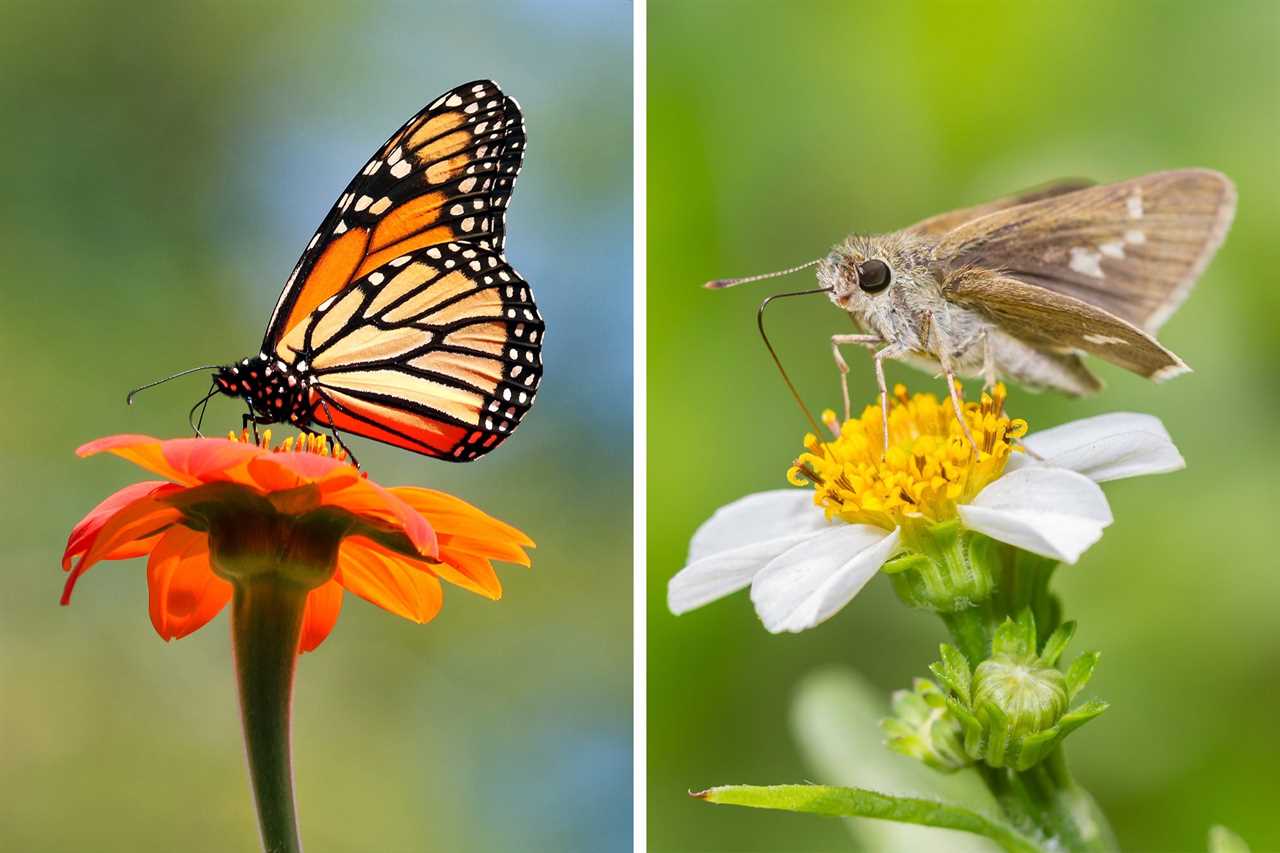
Think quick and name a type of butterfly. Monarch, swallowtail, painted lady, blue and hairstreak probably come to mind.
Now name a type of moth. Stumped? That might be because butterflies, and especially planting for butterflies, captivates our attention. I mean, who ever heard of a moth garden?
But there are actually 160,000 known species of moths vs. 17,500 species of butterflies. Both frequent our gardens and pollinate our plants. But who takes home the gold as the better pollinator? Let’s find out.
What’s the Difference Between a Butterfly and a Moth?
Butterflies and moths belong to a diverse group of insects known as Lepidoptera, Latin for “scaly wing.” They have similar lifecycles, progressing from egg to caterpillar to pupae before metamorphosing into winged adults.
“Butterflies are essentially moths that have specialized in being active during the day, so they’re more likely to be flying around your flowers while the sun is out than moths,” says Shiran Hershcovich, lepidopterist manager at the Butterfly Pavilion in Westminster, Colorado.
This evolution only recently came to light, helping explain why butterflies are generally more brightly colored than moths.
“That shift to feeding on the nectar of daytime flowering plants allowed these insects to shed their earth tones in favor of the riot of colors they’re known for today, which often act to attract mates or warn predators that they’re poisonous,” says Shubber Ali, CEO of Garden for Wildlife.
Other differences between butterflies and moths include:
- Moths tend toward feathery or fuzzy antennae.
- Butterfly antennae are always thin and clubbed or hooked at the end, and never fuzzy.
- Moths tend to have stouter, furrier-looking bodies than butterflies, helping them retain heat better during cooler nights.
- Moths can spin a silk cocoon to protect their pupae. Butterflies form a chrysalis.
- Butterflies fold their wings vertically above their backs, while moths hold theirs like a tent.
Of course, there are exceptions to some of these distinctions. Take hummingbird moths, which, like butterflies, are active during the day and sport showy hues.
Butterfly Pollinators: Pros and Cons
Butterflies certainly win in the bringing-humans-joy category, because we’re more likely to see them around in our gardens during the day. Beyond that, butterflies pro are generalists as nectar seekers, so they visit lots of flowers in a short amount of time. On the other hand, their larvae (caterpillars) chew on plants as they grow, making them seem destructive.
“But in reality, these plants are their host plants and are meant to be eaten,” says Ali. “Although damage to the plant can appear harmful, many of these plants recover quickly.”
Moth Pollinators: Pros and Cons
Moths win in the diversity category. With nearly 10 moth species for each butterfly species, some moths have become key specialists, pollinating plants that few others can. Example: The yucca moth and the yucca plant.
“No other animal can pollinate this plant,” says Hershcovich. “They’re in a symbiotic relationship, which means that they both depend on each other for survival.”
But from our human perception, moths are drab and often viewed as pests. Similar to butterflies, moth caterpillars can also destroy crops — fruit, vegetables, even tobacco. “On the other hand, these caterpillars are also very effective at controlling weedy plants,” says Ali.
Is a Butterfly or a Moth the Better Pollinator?
No one actually knows.
Most studies have focused on pollinators active during the day, like butterflies and bees, so there’s not a lot of direct scientific evidence comparing moths with butterflies. But a recent study from the University of Sussex concluded moths might be more efficient pollinators than bees.
“This is partly because moths have a much shorter time to pollinate at night, so they pollinate faster than daytime flying insects,” says Ali.
But more importantly, Hershcovich and Ali say it’s a misconception to think one pollinator can rule above the others. Butterflies and moths are essential pollinators, and a healthy ecosystem requires an abundance and diversity of each. Plus, caterpillars from both are integral to the food web. Many birds require hundreds of caterpillars a day to feed their young.
Are Other Insects Better Pollinators Than Butterflies and Moths?
Yes, and not just bees.
“The unsung heroes of pollination are flies, beetles and wasps,” says Ali. “Hoverflies are very efficient and important pollinators and are unknown to the general public.”
But butterflies and moths are still pollination stars. Some even visit flowers that bees don’t, sometimes in higher numbers. So again, the key to a successful garden and ecosystem is diversity.
“Plants and insects have evolved together, and many plants have special anatomical features or scents that align with a specific insect species,” says Ali.
Combined, pollinators are essential for the survival of the world as we know it. “They assist with plant reproduction, and in turn those plants give us food and oxygen,” Hershcovich says. “If we were to lose any of these pieces, our plants would suffer and in turn survival of life as we know it turns precarious.”
To support butterflies and moths, learn more about insects in your area, plant lots of native plants, reduce or eliminate pesticide use, be mindful of water consumption and turn off all unnecessary lights at night.
“To go the extra mile, join a community science program in your area that supports pollinators, like Butterfly Pavilion’s Colorado Butterfly Monitoring Network,” Hershcovich says.
Did you miss our previous article...
https://rsssuperfeeds.com/life-hacks/how-to-make-a-lemonade-stand






